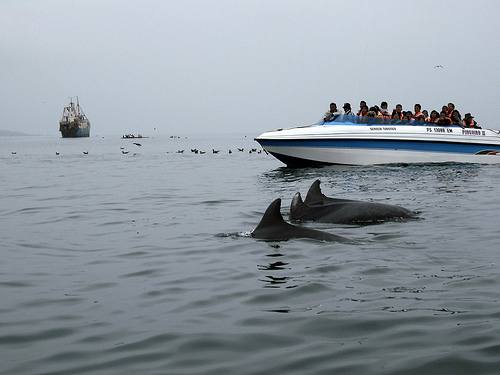[All links lead to sites in Spanish unless otherwise stated]
Dolphins [en] are among the most intelligent creatures on the planet, found in almost all the oceans in the world and with very few natural predators. In Peru they are found along various sections of the coast, including Lima's beaches where they swim alongside surfers, in the Paracas National Reservation, or on Piura's coastline, in the north of Peru, which is a spot also enjoyed by humpback whales.
This is the reason the news that in the first part of this year 3,000 dolphins have been found dead along the north coast of the country has caused such astonishment. Carlos Yaipén-Llanos, director of ORCA [Scientific Organisation for Conservation of Aquatic Animals], a Peruvian marine life conservation organisation, points out that these deaths are the result of “an acoustic impact that is created by deep-sea equipment used for the detection of oil, gas and other minerals”.

Dolphins in Pisco, Perú. Photo by Flickr user Alicia0928 under CC license. Attribution 2.0 Generic (CC BY 2.0).
The director of ORCA also reveals that it has been deduced from the forensic analises of the dolphins that they suffered from “acute decompression syndrome evidenced by fractures in the periostial bones and hemorrhaging in the middle ear, disseminated pulmonary emphasema, and air bubbles in organs such as the liver, kidneys and blood vessels”.
A subsequent newspaper report mentions that it is the use of exploration technology known as Sísmica 3d which causes the acoustic impacts that affect the dolphins. The company BPZ [en], based in Tumbes (to the north of Piura), is using this form of exploration to gather information on oil and natural gas deposits. This company has denied that their research causes the deaths of marine species, but the report on environmental impact indicates that this technology does have its consequences.
President of the Congress Daniel Abugattás has declared his hopes that the ministers of environment, production, energy, and mining inform the Peruvian parliament about this case. Another source suggests that it is IMARPE, the Instituto del Mar del Perú [Peruvian Sea Institute], that should release an official report on the matter.
Hardy Jones, the founder of BlueVoice.org [en], filmmaker and activist for the conservation of marine life, went to Peru to experience Dr. Yaipén-Llanos’ primary reports of the 25th March. Already on Peru's northern coast, he tweeted [en] on the 27th March:
Found 615 dead
#dolphins on 135 kilometers of beach N of San Jose, Peru. Tragedy unspeakable. Please retweet. This must be investigated.
On his personal blog he describes [en] in greater detail how he found out about these events, his trip to Peru and what he saw there:
Carlos and his team performed necropsies on a couple of the dolphins. Seeing a new born common dolphin, umbilicus still attached was wrenching.
We raced along the hard sand at the edge of the surfline crying out when we saw a dead dolphin. At first they came every couple minutes. But then we’d hit intervals when the cries would go “dolphin! Delphin! Otro! Dos mas! There’s another one up by the dune.”
Later he posted [en] part of Dr. Yaipén-Llanos’ report on BlueVoice's blog:
As previously reported, two species have been affected: Long beaked common dolphin (Delphinus capensis) and Burmeister’s porpoise (Phocoena spinipinnis). We counted 615 common dolphins. All age classes were affected: Adult males, females, lactating females, juveniles, calves and newborns. We counted 19 porpoises, only females and calves.
ORCA has shared photos on Facebook of their findings. Dr. Yaipén-Llanos was interviewed on Spanish CNN about the events. The following video [en] is part of Hardy Jones and Carlos Yaipén-Llanos’ journey along the coast of Northern Peru:
Meanwhile, environment and fishing ministers met on the 10th April to report on the link between oil exploration and the deaths of the dolphins. They also had to report on the measures being taken to avoid greater environmental impact on marine fauna, now that a report has shown that approximately 20,000 dolphins, as well as other species, are in mortal danger. Inquiries into the use of Sísmica 3d have been planned along the entire Peruvian coastline.







11 comments
Thanks. The company should be further investigated and regulated to protect dolphins.
god this is horrible :(
What can I write now, how can I comment this? Are any already not used words to explain this crime?
Saludos
Let us hope they get to the bottom of this real soon.
What is Sismica 3d technology?
I understand that the periotic bone is very hard and strong with a density similar to teeth. At first, before I googled periotic bone (because I had no idea what it was) I was imagining damaged tissue—like a busted eardrum—NOT BONE, which this is.
What kind of acoustic would be needed to fracture hard bone? Even more importantly, and what I’m trying to understand is what that would feel like? I can’t imagine the kind of sound or frequency this would be. Is it loud? Does it shake your body like a seizure? What would it feel like? (I apologize if these are stupid questions)
I feel lost in the science, and am looking for any “like-comparisons” or metaphors so as to try to understand 1) the technology causing this and 2) what this would feel like in human or dolphin terms.
It would also help if I knew Spanish, but I don’t.
Any information anyone can provide, even the tiniest would be so helpful and welcomed.
This is a tradgedy! Here are two stories, one on the slaughter of dolphins (http://bit.ly/mlLbyj) and one on the impact of the sonar in San Diego on dolphins (http://bit.ly/tIzwPd).
This is terrible and tragic, and must be stopped. The pain would be overwhelming. Imagine something blowing up inside your head.
The other day, a friend sent me a video of 30 live dolphins that were suddenly beached in Brazil, and rescued by bystanders. I thought it very odd that dolphins would wash up on shore like this. Now I wonder if this incident could be related to some of these practices.
researchers at a marine animal organization in Peru (ORCA) finally concluded that seismic surveying for petroleum is to blame
http://www.thepetitionsite.com/509/308/950/stop-killing-dolphins-with-sonar/